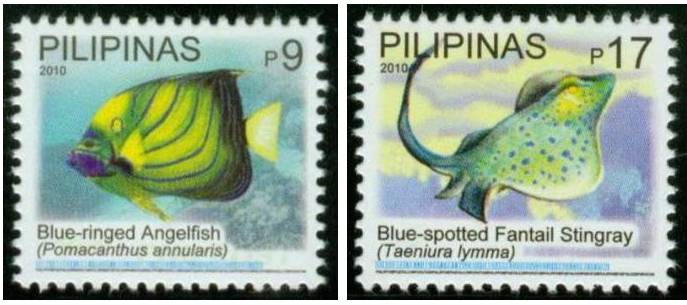2010, December 13. Philippine Marine Biodiversity - Definitives
Litho Offset. Amstar Company, Inc. Perf. 13.5
Singles, Sheets of 100 (10 x 10)

9p - Blue-ringed Angelfish - Singles (2,420,000)
17p - Blue-spotted Fantail Stingray - Singles (330,000)
Source: Coral Reef Animals of the Indo-Pacific by Dr. Terence Gosliner
First Day Covers: Manila
Blue-ringed Angelfish (Pomacanthus Annularis). The Blue-ringed Angelfish is a handsome specimen both as a juvenile and as an adult. Though juveniles are very similar in appearance to several other members of Pomacanthus that are black with white bands, the adult is easily distinguished by its vibrant blue patterning on a yellowish brown background. In the wild, Blue Ring males defend several females in a very small area. Blue Ring Males and females are not distinguishable from each other. They are egg-scatterers and usually breed at dusk. In the wild, the larvae drift for a month before developing into juventiles. In captivity, the larvae rarely survive.(http://saltwater.tropicalfishandaquariums.com/Angelfish/BlueRingAngel.asp);
(http://animal-world.com/encyclo/marine/angels/BlueRingedAngelfish.php)
Blue-spotted Fantail Stingray (Taeniura Lymma). Also known as Blue-spotted ray, Blue spotted stingray, Blue spotted ray, and Ribbontail stingray, is a colorful stingray with large bright blue spots on an oval, elongated disc and blue side-stripes along the tail. The snout is rounded and angular and the disc has broadly rounded outer corners. They have a short tapering tail that is less than twice the body length when intact, with a broad lower caudal finfold that extends to the tail tip. The disc has no large thorns but does have small, flat denticles along the midback in adults. There is usually 1 medium-sized stinging spine on the tail found further from the base than most stingrays. They are gray-brown to yellow, or olive-green to reddish brown in color on the dorsal side, white on the ventral side. They reach a maximum length about 70 cm. The blue-spotted ray is found around coral reefs, they are only rarely found buried under the sand. They migrate in groups into shallow sandy areas during the rising tide to feed on mollusks, worms, shrimps, and crabs; they disperse at low tide to seek shelter in caves and under ledges. (http://marinebio.org/species.asp?id=320)
-
Marine Biodiversity
-
Marine Life